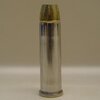Damon Larsen
Member
- Joined
- Oct 11, 2019
- Messages
- 52
Hey guys, I only have experience in taper crimping with auto loader rounds.
I’m getting ready to set my dies for 357 Magnum on my XL750, and have no idea what the amount of roll crimp I should apply.
I don’t want to under/over crimp. What is the method to know you’ve applied the right amount? With taper crimp, it’s easy because you just remove the belling. This roll crimp thing has me confused. I’ll be loading with magnum powder, so I don’t want my gun to act as a kinetic bullet puller.
I’m also worried that if I load progressively, the 5 to 10 thousandths variation I get will make me miss the canalure. Should I just load one round at a time to prevent that variation?
I’m using Hornady XTP/HP 158gr. bullets, with Vihtavouri N105 if that helps at all. Thanks in advance for your replies.
I’m getting ready to set my dies for 357 Magnum on my XL750, and have no idea what the amount of roll crimp I should apply.
I don’t want to under/over crimp. What is the method to know you’ve applied the right amount? With taper crimp, it’s easy because you just remove the belling. This roll crimp thing has me confused. I’ll be loading with magnum powder, so I don’t want my gun to act as a kinetic bullet puller.
I’m also worried that if I load progressively, the 5 to 10 thousandths variation I get will make me miss the canalure. Should I just load one round at a time to prevent that variation?
I’m using Hornady XTP/HP 158gr. bullets, with Vihtavouri N105 if that helps at all. Thanks in advance for your replies.
Last edited:






